2015 NISSAN VERSA NOTE maintenance
[x] Cancel search: maintenancePage 355 of 384
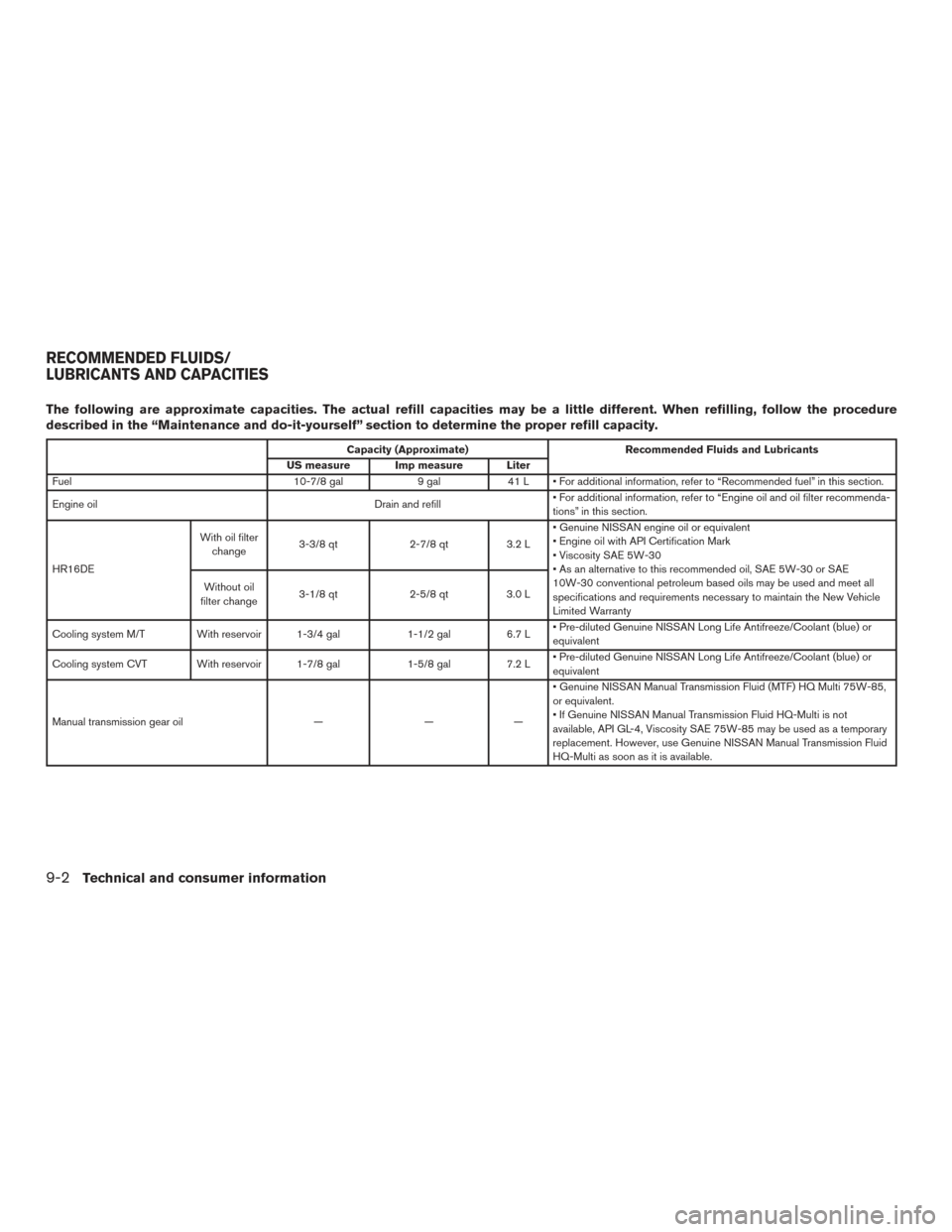
The following are approximate capacities. The actual refill capacities may be a little different. When refilling, follow the procedure
described in the “Maintenance and do-it-yourself” section to determine the proper refill capacity.
Capacity (Approximate)Recommended Fluids and Lubricants
US measure Imp measure Liter
Fuel 10-7/8 gal9 gal41 L • For additional information, refer to “Recommended fuel” in this section.
Engine oil Drain and refill• For additional information, refer to “Engine oil and oil filter recommenda-
tions” in this section.
HR16DE With oil filter
change 3-3/8 qt
2-7/8 qt3.2 L• Genuine NISSAN engine oil or equivalent
• Engine oil with API Certification Mark
• Viscosity SAE 5W-30
• As an alternative to this recommended oil, SAE 5W-30 or SAE
10W-30 conventional petroleum based oils may be used and meet all
specifications and requirements necessary to maintain the New Vehicle
Limited Warranty
Without oil
filter change 3-1/8 qt
2-5/8 qt3.0 L
Cooling system M/T With reservoir 1-3/4 gal 1-1/2 gal6.7 L• Pre-diluted Genuine NISSAN Long Life Antifreeze/Coolant (blue) or
equivalent
Cooling system CVT With reservoir 1-7/8 gal 1-5/8 gal7.2 L• Pre-diluted Genuine NISSAN Long Life Antifreeze/Coolant (blue) or
equivalent
Manual transmission gear oil ———• Genuine NISSAN Manual Transmission Fluid (MTF) HQ Multi 75W-85,
or equivalent.
• If Genuine NISSAN Manual Transmission Fluid HQ-Multi is not
available, API GL-4, Viscosity SAE 75W-85 may be used as a temporary
replacement. However, use Genuine NISSAN Manual Transmission Fluid
HQ-Multi as soon as it is available.
RECOMMENDED FLUIDS/
LUBRICANTS AND CAPACITIES
9-2Technical and consumer information
Page 359 of 384
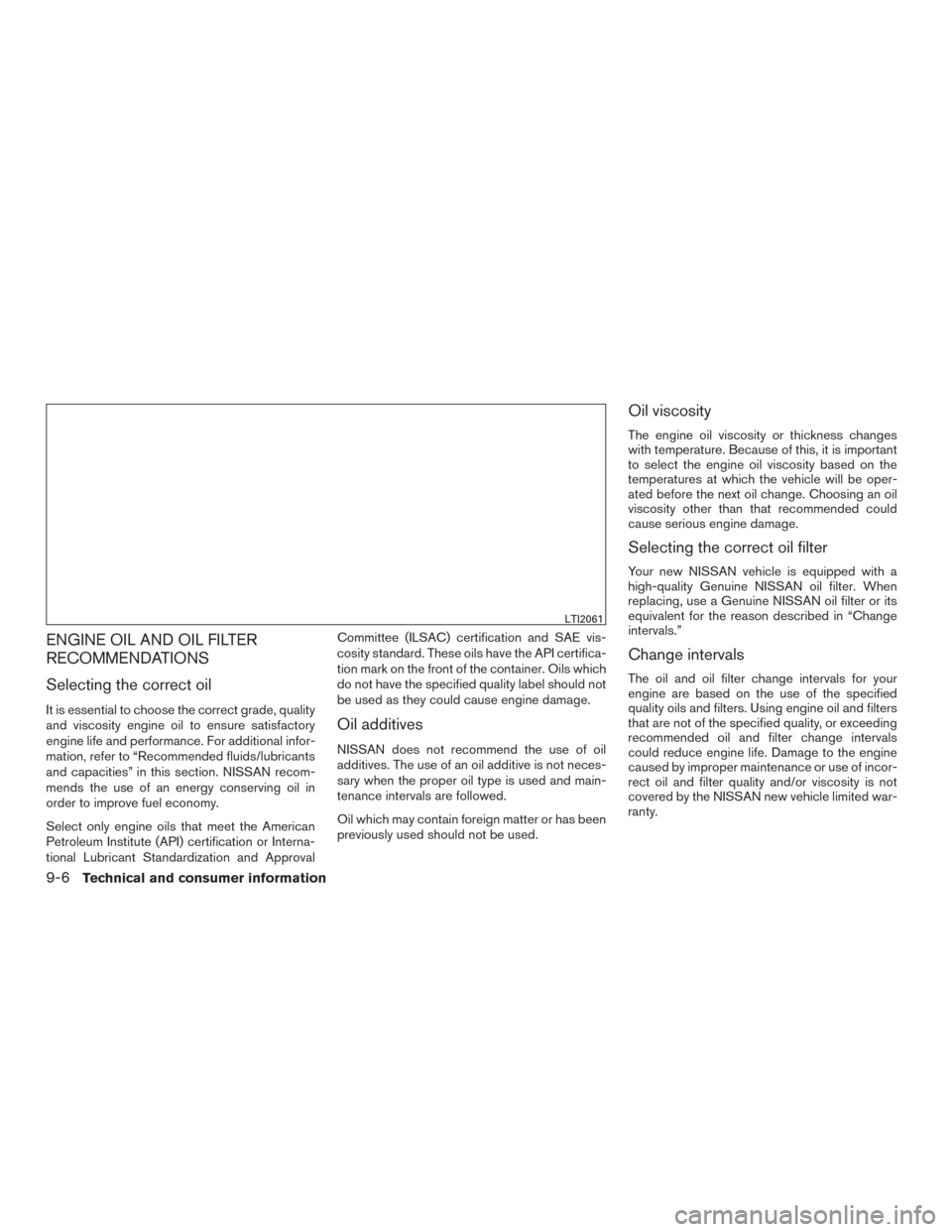
ENGINE OIL AND OIL FILTER
RECOMMENDATIONS
Selecting the correct oil
It is essential to choose the correct grade, quality
and viscosity engine oil to ensure satisfactory
engine life and performance. For additional infor-
mation, refer to “Recommended fluids/lubricants
and capacities” in this section. NISSAN recom-
mends the use of an energy conserving oil in
order to improve fuel economy.
Select only engine oils that meet the American
Petroleum Institute (API) certification or Interna-
tional Lubricant Standardization and ApprovalCommittee (ILSAC) certification and SAE vis-
cosity standard. These oils have the API certifica-
tion mark on the front of the container. Oils which
do not have the specified quality label should not
be used as they could cause engine damage.Oil additives
NISSAN does not recommend the use of oil
additives. The use of an oil additive is not neces-
sary when the proper oil type is used and main-
tenance intervals are followed.
Oil which may contain foreign matter or has been
previously used should not be used.
Oil viscosity
The engine oil viscosity or thickness changes
with temperature. Because of this, it is important
to select the engine oil viscosity based on the
temperatures at which the vehicle will be oper-
ated before the next oil change. Choosing an oil
viscosity other than that recommended could
cause serious engine damage.
Selecting the correct oil filter
Your new NISSAN vehicle is equipped with a
high-quality Genuine NISSAN oil filter. When
replacing, use a Genuine NISSAN oil filter or its
equivalent for the reason described in “Change
intervals.”
Change intervals
The oil and oil filter change intervals for your
engine are based on the use of the specified
quality oils and filters. Using engine oil and filters
that are not of the specified quality, or exceeding
recommended oil and filter change intervals
could reduce engine life. Damage to the engine
caused by improper maintenance or use of incor-
rect oil and filter quality and/or viscosity is not
covered by the NISSAN new vehicle limited war-
ranty.
LTI2061
9-6Technical and consumer information
Page 360 of 384
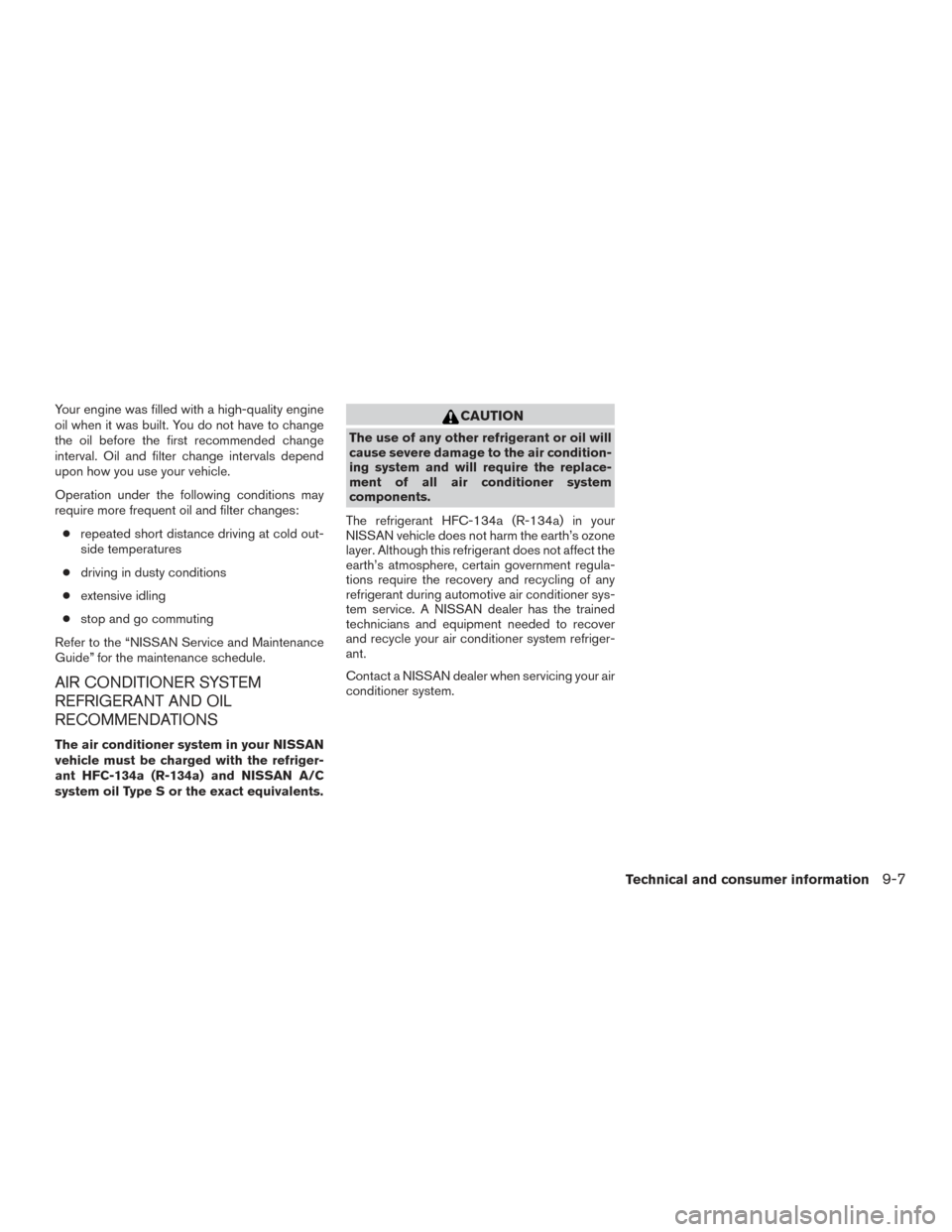
Your engine was filled with a high-quality engine
oil when it was built. You do not have to change
the oil before the first recommended change
interval. Oil and filter change intervals depend
upon how you use your vehicle.
Operation under the following conditions may
require more frequent oil and filter changes:● repeated short distance driving at cold out-
side temperatures
● driving in dusty conditions
● extensive idling
● stop and go commuting
Refer to the “NISSAN Service and Maintenance
Guide” for the maintenance schedule.
AIR CONDITIONER SYSTEM
REFRIGERANT AND OIL
RECOMMENDATIONS
The air conditioner system in your NISSAN
vehicle must be charged with the refriger-
ant HFC-134a (R-134a) and NISSAN A/C
system oil Type S or the exact equivalents.
CAUTION
The use of any other refrigerant or oil will
cause severe damage to the air condition-
ing system and will require the replace-
ment of all air conditioner system
components.
The refrigerant HFC-134a (R-134a) in your
NISSAN vehicle does not harm the earth’s ozone
layer. Although this refrigerant does not affect the
earth’s atmosphere, certain government regula-
tions require the recovery and recycling of any
refrigerant during automotive air conditioner sys-
tem service. A NISSAN dealer has the trained
technicians and equipment needed to recover
and recycle your air conditioner system refriger-
ant.
Contact a NISSAN dealer when servicing your air
conditioner system.
Technical and consumer information9-7
Page 373 of 384
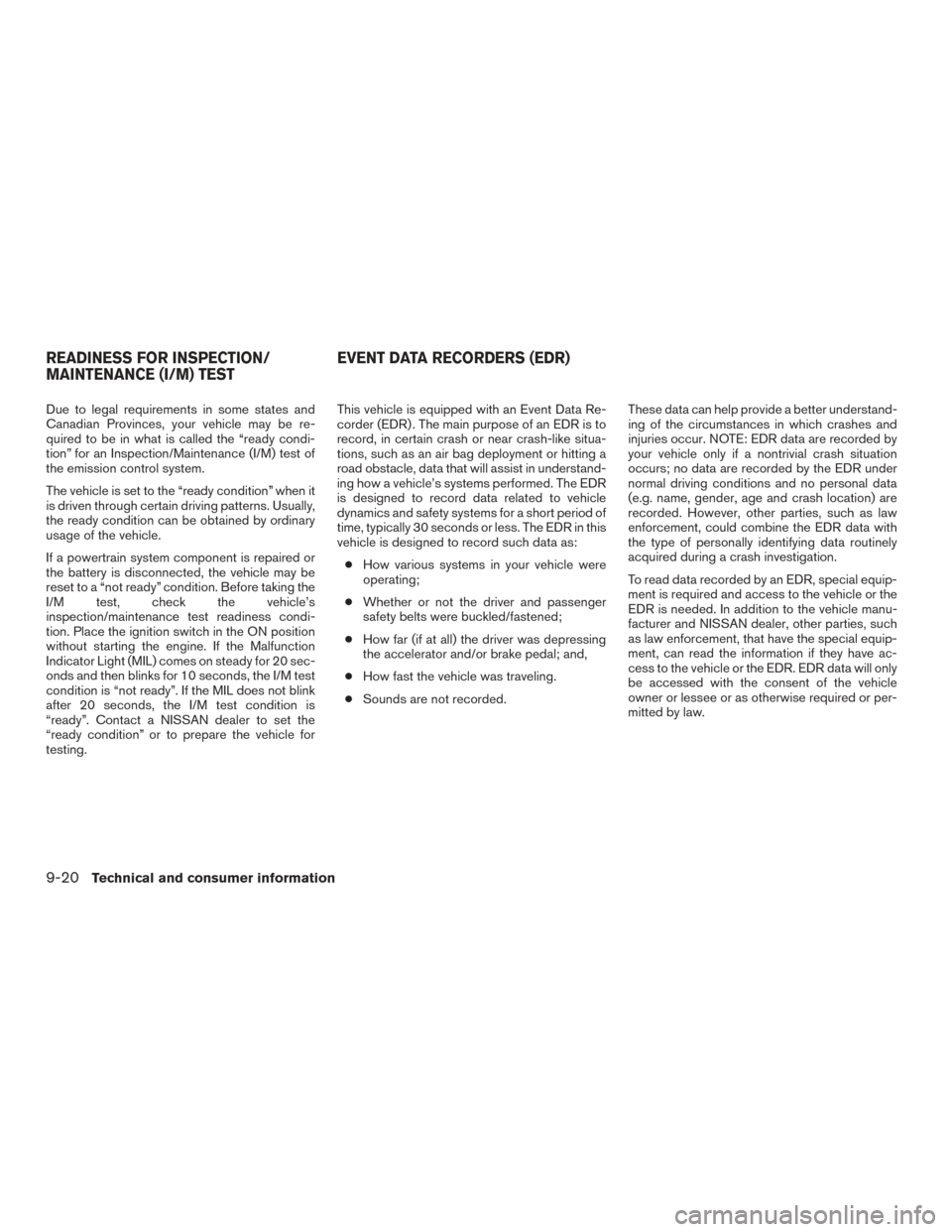
Due to legal requirements in some states and
Canadian Provinces, your vehicle may be re-
quired to be in what is called the “ready condi-
tion” for an Inspection/Maintenance (I/M) test of
the emission control system.
The vehicle is set to the “ready condition” when it
is driven through certain driving patterns. Usually,
the ready condition can be obtained by ordinary
usage of the vehicle.
If a powertrain system component is repaired or
the battery is disconnected, the vehicle may be
reset to a “not ready” condition. Before taking the
I/M test, check the vehicle’s
inspection/maintenance test readiness condi-
tion. Place the ignition switch in the ON position
without starting the engine. If the Malfunction
Indicator Light (MIL) comes on steady for 20 sec-
onds and then blinks for 10 seconds, the I/M test
condition is “not ready”. If the MIL does not blink
after 20 seconds, the I/M test condition is
“ready”. Contact a NISSAN dealer to set the
“ready condition” or to prepare the vehicle for
testing.This vehicle is equipped with an Event Data Re-
corder (EDR) . The main purpose of an EDR is to
record, in certain crash or near crash-like situa-
tions, such as an air bag deployment or hitting a
road obstacle, data that will assist in understand-
ing how a vehicle’s systems performed. The EDR
is designed to record data related to vehicle
dynamics and safety systems for a short period of
time, typically 30 seconds or less. The EDR in this
vehicle is designed to record such data as:
● How various systems in your vehicle were
operating;
● Whether or not the driver and passenger
safety belts were buckled/fastened;
● How far (if at all) the driver was depressing
the accelerator and/or brake pedal; and,
● How fast the vehicle was traveling.
● Sounds are not recorded. These data can help provide a better understand-
ing of the circumstances in which crashes and
injuries occur. NOTE: EDR data are recorded by
your vehicle only if a nontrivial crash situation
occurs; no data are recorded by the EDR under
normal driving conditions and no personal data
(e.g. name, gender, age and crash location) are
recorded. However, other parties, such as law
enforcement, could combine the EDR data with
the type of personally identifying data routinely
acquired during a crash investigation.
To read data recorded by an EDR, special equip-
ment is required and access to the vehicle or the
EDR is needed. In addition to the vehicle manu-
facturer and NISSAN dealer, other parties, such
as law enforcement, that have the special equip-
ment, can read the information if they have ac-
cess to the vehicle or the EDR. EDR data will only
be accessed with the consent of the vehicle
owner or lessee or as otherwise required or per-
mitted by law.
READINESS FOR INSPECTION/
MAINTENANCE (I/M) TEST
EVENT DATA RECORDERS (EDR)
9-20Technical and consumer information
Page 378 of 384

Event data recorders..............9-20
Exhaust gas (Carbon monoxide) .........5-2
Explanation of maintenance items ........8-2
Extendedstorageswitch ............8-23
F
Flashers (See hazard warning flasher switch) . .6-2
Flat tire .......................6-3
Floor mat positioning aid .............7-5
Fluid Brake fluid ..................8-13
Capacities and recommended
fuel/lubricants .................9-2
Continuously Variable Transmission (CVT)
fluid......................8-12
Engine coolant .................8-8
Engine oil ...................8-9
F.M.V.S.S. certification label ...........9-11
Foglightswitch .................2-28
Front air bag system
(See supplemental restraint system) ......1-49
Frontseats.....................1-2
Fuel Capacities and recommended
fuel/lubricants .................9-2
Fuel economy ................5-25
Fuel-filler door and cap ...........3-26
Fuel-filler door lock opener lever ......3-26
Fuel gauge ...................2-9
Fuel octane rating ...............9-5
Fuel recommendation .............9-4
Loose fuel cap warning ........2-6,3-27
Fuel gauge .....................2-9
Fuses.......................8-21 Fusiblelinks ...................8-21
G
Gascap .....................3-26
Gauge Engine coolant temperature gauge .....2-8
Fuel gauge ...................2-9
Odometer ...................2-5
Speedometer .................2-4
Tachometer ..................2-8
Trip computer ................2-10
Trip odometer .................2-5
General maintenance ...............8-2
Glovebox.....................2-34
Gloveboxlock..................2-34
Grocery hooks ..................2-37
H
Hands-free phone system,
Bluetooth®................4-76,4-91
Hazard warning flasher switch ..........6-2
Headlight and turn signal switch ........2-25
Headlight control switch ............2-25
Headlights ....................8-26
Head restraints ..................1-5
Heated seats ...................2-29
Heater Heater and air conditioner controls .....4-23
Heater operation ...............4-25
Hood release ...................3-24
Horn .......................2-29 I
Ignition switch ...................5-8
Ignition Switch Push-Button Ignition Switch ........5-10
Immobilizer system ......2-22,3-4,5-10,5-13
Important vehicle information label .......9-11
Increasing fuel economy .............5-25
Indicator
lights and audible reminders
(See warning/indicator lights and audible
reminders)....................2-13
Inside mirror ...................3-30
Instrument brightness control ..........2-27
Instrumentpanel...............0-6,2-2
Instrument panel dimmer switch ........2-27
Intelligent Key system Key operating range .............3-13
Key operation ................3-14
Mechanical key ................3-4
Remote keyless entry operation.......3-18
Troubleshooting guide ............3-23
Warning signals ...............3-23
Interior light ................2-40,2-41
iPod®Player ............... 4-65, 4-67
ISOFIX child restraints .............1-23
J
Jump starting ...............6-12,8-16
K
Key.........................3-2
Key fob battery replacement ..........8-24
10-3
Page 379 of 384
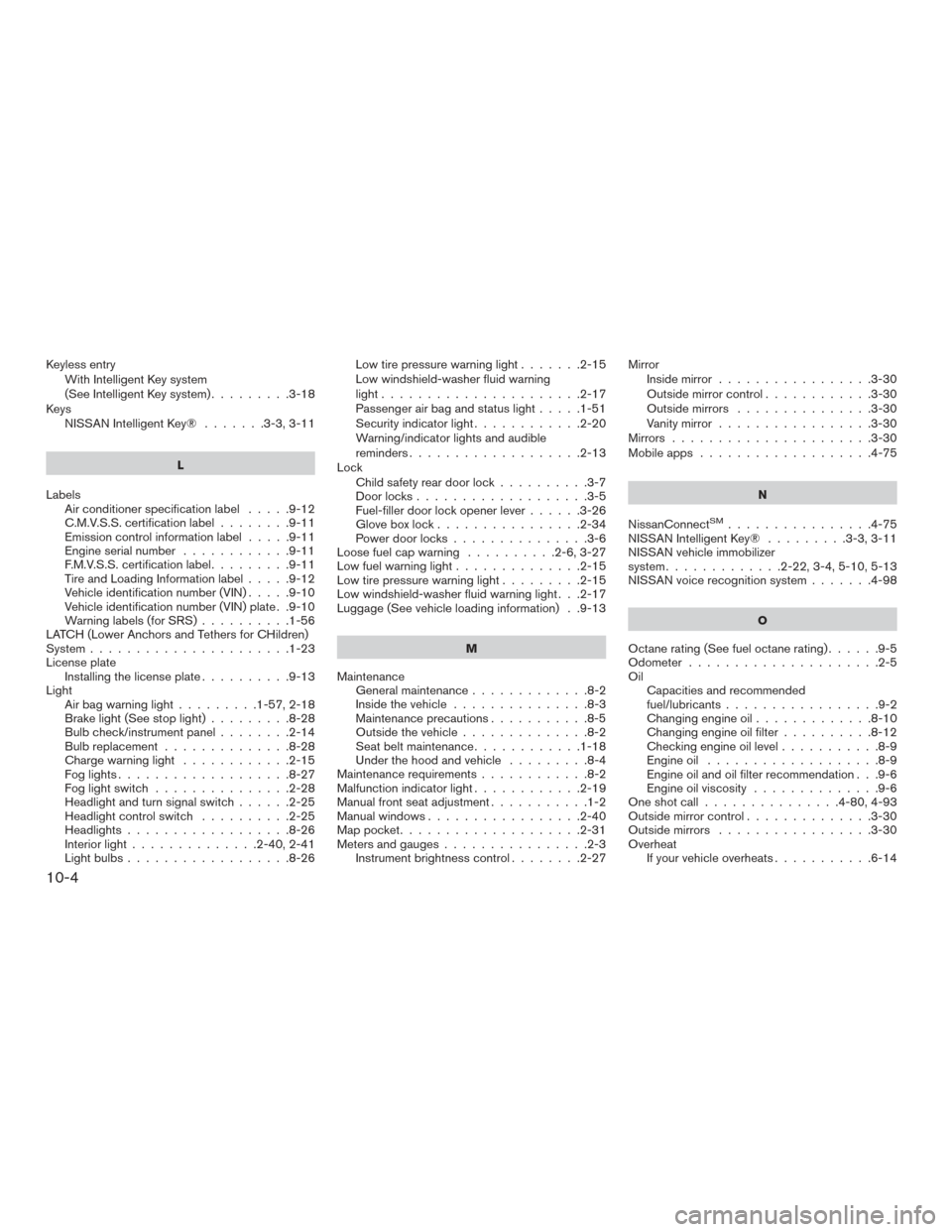
Keyless entryWith Intelligent Key system
(See Intelligent Key system) .........3-18
Keys NISSAN Intelligent Key® .......3-3,3-11
L
Labels Air conditioner specification label .....9-12
C.M.V.S.S. certification label ........9-11
Emissioncontrolinformationlabel.....9-11
Engine serial number ............9-11
F.M.V.S.S. certification label .........9-11
Tire and Loading Information label .....9-12
Vehicle identification number (VIN) .....9-10
Vehicle identification number (VIN) plate . .9-10
Warning labels (for SRS) ..........1-56
LATCH (Lower Anchors and Tethers for CHildren)
System ......................1-23
License plate Installing the license plate ..........9-13
Light Airbagwarninglight.........1-57,2-18
Brake light (See stop light) .........8-28
Bulb check/instrument panel ........2-14
Bulb replacement ..............8-28
Charge warning light ............2-15
Foglights...................8-27
Foglightswitch ...............2-28
Headlight and turn signal switch ......2-25
Headlight control switch ..........2-25
Headlights ..................8-26
Interiorlight..............2-40,2-41
Lightbulbs..................8-26 Low tire pressure warning light
.......2-15
Low windshield-washer fluid warning
light......................2-17
Passenger air bag and status light .....1-51
Security indicator light ............2-20
Warning/indicator lights and audible
reminders ...................2-13
Lock Child safety rear door lock ..........3-7
Door locks ...................3-5
Fuel-filler door lock opener lever ......3-26
Gloveboxlock................2-34
Power door locks ...............3-6
Loose fuel cap warning ..........2-6,3-27
Lowfuelwarninglight..............2-15
Low tire pressure warning light .........2-15
Low windshield-washer fluid warning light . . .2-17
Luggage (See vehicle loading information) . .9-13
M
Maintenance Generalmaintenance.............8-2
Insidethevehicle...............8-3
Maintenance precautions ...........8-5
Outside the vehicle ..............8-2
Seatbeltmaintenance............1-18
Underthehoodandvehicle .........8-4
Maintenancerequirements............8-2
Malfunction indicator light ............2-19
Manual front seat adjustment ...........1-2
Manual windows .................2-40
Map pocket ....................2-31
Meters and gauges ................2-3
Instrument brightness control ........2-27Mirror
Inside mirror .................3-30
Outside mirror control ............3-30
Outside mirrors ...............3-30
Vanity mirror .................3-30
Mirrors ......................3-30
Mobileapps ...................4-75
N
NissanConnect
SM................4-75
NISSAN Intelligent Key® .........3-3,3-11
NISSAN vehicle immobilizer
system .............2-22,3-4,5-10,5-13
NISSAN voice recognition system .......4-98
O
Octane rating (See fuel octane rating) ......9-5
Odometer .....................2-5
Oil Capacities and recommended
fuel/lubricants.................9-2
Changingengineoil.............8-10
Changing engine oil filter ..........8-12
Checking engine oil level ...........8-9
Engineoil ...................8-9
Engine oil and oil filter recommendation . . .9-6
Engine oil viscosity ..............9-6
Oneshotcall...............4-80,4-93
Outside mirror control ..............3-30
Outside mirrors .................3-30
Overheat If your vehicle overheats ...........6-14
10-4
Page 380 of 384

Owner’s manual order form...........9-21
Owner’s manual/service manual order
information ....................9-21
P
Parking Parking brake operation ...........5-20
Parking/parking on hills ...........5-25
Phone, Bluetooth® hands-free
system ...................4-76,4-91
Power Power door locks ...............3-6
Power outlet .................2-31
Power rear windows .............2-39
Power steering system ...........5-26
Power windows ...............2-37
Rear power windows ............2-39
Power outlet ...................2-31
Power steering ..................5-26
Precautions Maintenance precautions ...........8-5
Precautions on booster
seats...........1-21,1-28,1-34,1-39
Precautions on child
restraints .........1-21,1-28,1-34,1-39
Precautionsonseatbeltusage.......1-10
Precautions on supplemental restraint
system ....................1-42
Precautions when starting and driving ....5-2
Programmable features ..........4-7,4-45
Push starting ...................6-14 R
Radio Car phone or CB radio ...........4-76
FM-AM radio with compact disc (CD)
player .....................4-40
FM/AM radio with compact disc (CD)
player .....................4-44
FM/AM/SAT radio with compact disc (CD)
player .................4-49,4-54
Steering wheel audio control switch ....4-72
Readiness for inspection maintenance (I/M)
test........................9-20
Rear center seat belt ..............1-15
Rear power windows ..............2-39
Rearseat......................1-4
RearView Monitor .........4-10,4-11,4-13
Rear window defroster switch .........2-25
Rear window wiper and washer switches . . .2-24
Recorders Eventdata..................9-20
Refrigerant recommendation ...........9-7
Registering your vehicle in another country . .9-10
Reporting safety defects (US only) .......9-19
S
Safety Child safety rear door lock ..........3-7
Child seat belts .....1-21,1-28,1-34,1-39
Reporting safety defects (US only) .....9-19
Seat adjustment Frontmanualseatadjustment ........1-2
Rear seat adjustment .............1-4 Seatbackpockets................2-32
Seat belt
Child safety ..................1-19
Infants and small children ..........1-20
Injured Person ................1-13
Largerchildren................1-20
Precautions on seat belt usage .......1-10
Pregnant women ...............1-13
Rear center seat belt ............1-15
Seatbeltextenders .............1-18
Seatbeltmaintenance............1-18
Seatbelts...................1-10
Shoulder belt height adjustment ......1-18
Three-point type with retractor .......1-13
Seat belt extenders ...............1-18
Seatbeltwarninglight..............2-18
Seats Adjustment ...................1-2
Armrests....................1-5
F
rontseats...................1-2
Heatedseats.................2-29
Manualfrontseatadjustment.........1-2
Rearseat....................1-4
Security indicator light ..............2-20
Security system (NISSAN vehicle immobilizer
system) , engine start .....2-22,3-4,5-10,5-13
Self-adjusting brakes ..............8-20
Service manual order form ...........9-21
Servicing air conditioner .............4-31
Setting button ...............4-7,4-45
Shifting Continuously Variable Transmission
(CVT) .....................5-16
Manual transmission .............5-19
Shiftleverlockrelease..............5-17
Shoulder belt height adjustment ........1-18
10-5
Page 383 of 384
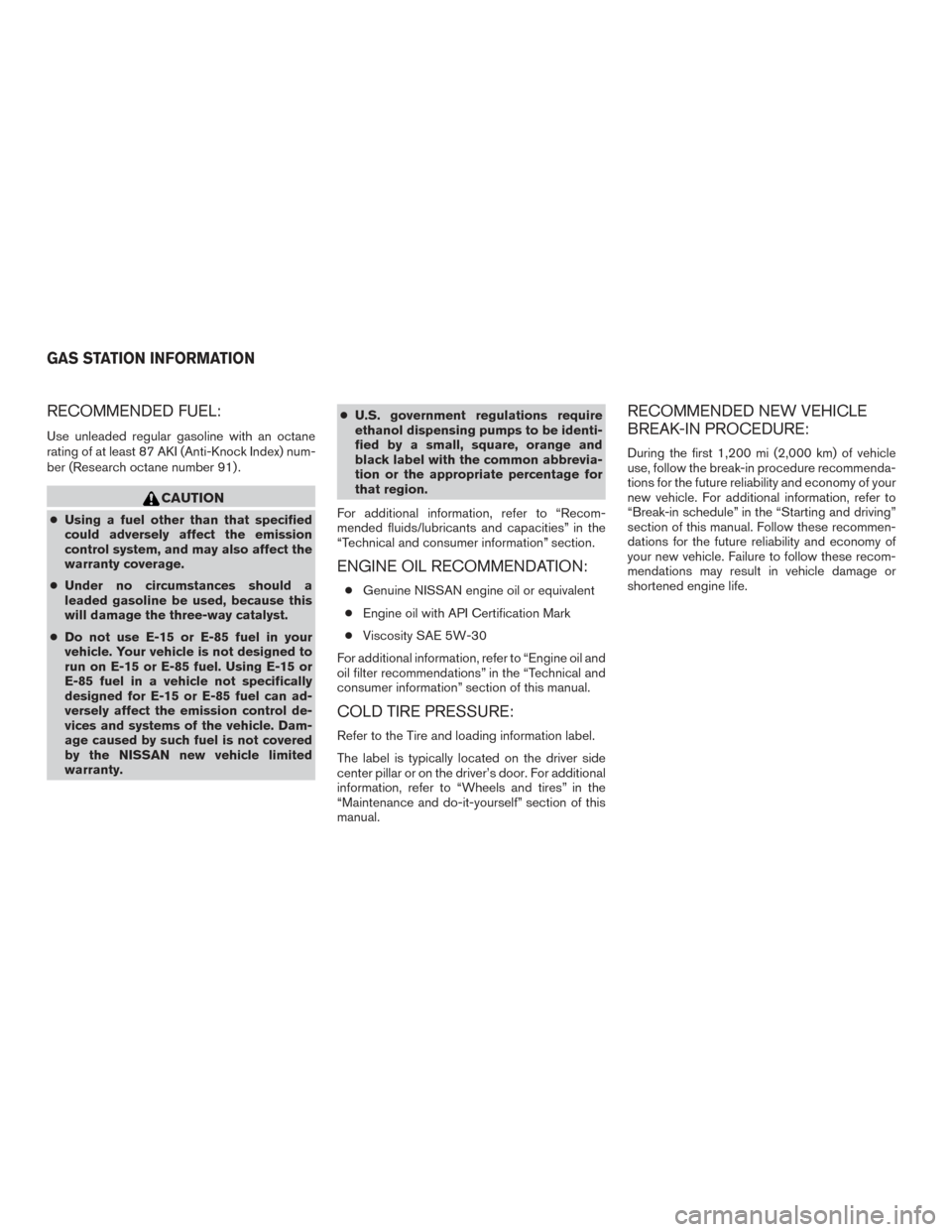
RECOMMENDED FUEL:
Use unleaded regular gasoline with an octane
rating of at least 87 AKI (Anti-Knock Index) num-
ber (Research octane number 91) .
CAUTION
●Using a fuel other than that specified
could adversely affect the emission
control system, and may also affect the
warranty coverage.
● Under no circumstances should a
leaded gasoline be used, because this
will damage the three-way catalyst.
● Do not use E-15 or E-85 fuel in your
vehicle. Your vehicle is not designed to
run on E-15 or E-85 fuel. Using E-15 or
E-85 fuel in a vehicle not specifically
designed for E-15 or E-85 fuel can ad-
versely affect the emission control de-
vices and systems of the vehicle. Dam-
age caused by such fuel is not covered
by the NISSAN new vehicle limited
warranty. ●
U.S. government regulations require
ethanol dispensing pumps to be identi-
fied by a small, square, orange and
black label with the common abbrevia-
tion or the appropriate percentage for
that region.
For additional information, refer to “Recom-
mended fluids/lubricants and capacities” in the
“Technical and consumer information” section.
ENGINE OIL RECOMMENDATION:
● Genuine NISSAN engine oil or equivalent
● Engine oil with API Certification Mark
● Viscosity SAE 5W-30
For additional information, refer to “Engine oil and
oil filter recommendations” in the “Technical and
consumer information” section of this manual.
COLD TIRE PRESSURE:
Refer to the Tire and loading information label.
The label is typically located on the driver side
center pillar or on the driver’s door. For additional
information, refer to “Wheels and tires” in the
“Maintenance and do-it-yourself” section of this
manual.
RECOMMENDED NEW VEHICLE
BREAK-IN PROCEDURE:
During the first 1,200 mi (2,000 km) of vehicle
use, follow the break-in procedure recommenda-
tions for the future reliability and economy of your
new vehicle. For additional information, refer to
“Break-in schedule” in the “Starting and driving”
section of this manual. Follow these recommen-
dations for the future reliability and economy of
your new vehicle. Failure to follow these recom-
mendations may result in vehicle damage or
shortened engine life.
GAS STATION INFORMATION